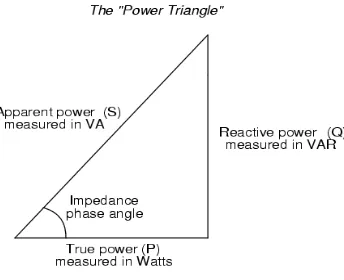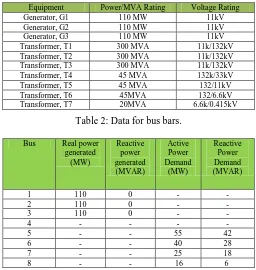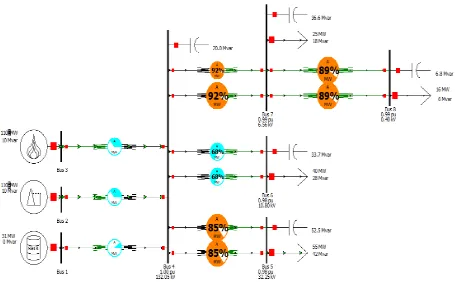|| Volume || 3 || Issue || 12 || December - 2014 || Pages || 61-67||
ISSN (e): 2319
–
1813 ISSN (p): 2319
–
1805
Analysing of a Shunt Compensator Installation
R. H. S. Soeprapto
1,A, A. F. A. Abd. Rahman
2,A, M. N. M. Nasir
3,A, Z. H.
Bohari
4,Aa Faculty of Electrical Engineering, Universiti Teknikal Malaysia Melaka, Hang Tuah Jaya, 76100, Durian
Tunggal Melaka
---ABSTRACT---Nowadays, electricity has become an important part of human lives. Electricity is needed to light up houses, buildings and even transports. Electricity comes from generators which produce power that are useful for loads. But, not all power that flow from generators is useful for a power system. Although reactive power is needed on power system, a high amount of it will cause problems such as the reduction of active power generated and poor voltage regulation. The reactive power consumption by loads must be compensated and this could be done by installing shunt compensator on the electrical network. An approach has been done to study about the performance of the system with and without compensator installed. This research presents a comprehensive study on the shunt compensation method. There were three methods used in finishing this research which are collecting data from electricity utility, literature review writing, and simulation using PowerWorld Simulator. The simulated network is evaluated in terms of its performance with and without compensator installed.
KEYWORDS : Shunt capacitor, power factor, voltage regulation, power loss, shunt compensation
--- --- Date of Submission: 1 December 2014 Date of Accepted: 25 December 2014 --- ---
I.
INTRODUCTION
Daily activities are mostly depending on electrical energy. Electricity is needed to power up various appliances such as washing machine, fans, lights, computers and air conditioners. This electricity comes from the generators at the generation side. The system will distribute electricity via power line by considering the realibility and economic wise based on need or demand required by consumer [1]. Buildings such as production factories and hospitals need a continuous supply of voltage and cannot afford to lose them. Once there is no electricity supplied to these buildings, it might cost a lot of money because devices and motors need electricity to operate. But, the existence of these devices and motors would cause the power system to not perform efficiently.
Motor has a lot of windings in it so it falls in the category of inductive load. Most loads that are being used are of the inductive type. Inductive loads when connected to the power system will cause induction to occur and this will make the power factor to drop. In order to overcome this problem, we need to install a capacitor which is commonly known as compensator to make the power factor correction.Compensation is a widely used technique in power system to improve the power system performance. There are two types of compensation techniques, namely series compensation and shunt compensation. The usage of a compensator can help to control the reactive power on a transmission line and even at the distribution level. Compensation is proven to solve problem such as maintenance of the flat voltage profile. This technique could also improve the transmission efficiency and the stability of the power system. But, the main reason that compensation is implemented is to improve the power factor [2].
Figure 1: Power triangle.
As the power system is connected to the loads that are mostly operating at low lagging power factor, the loads need a certain amount of lagging reactive power during peak load conditions [4]. However, the receiving end voltage could become low if the required amount of lagging reactive power is supplied directly by the generator at the sending end as the equipment starting from the sending end to the receiving end might be over loaded. The generated net VARs by the line during off peak conditions must be absorbed in order to achieve voltage stability.
II.
PROBLEM STATEMENT
The need of a stable power system is increasing rapidly throughout the years. To make sure the power system is stable and reliable, there need to be protective devices installed on the network, such as compensator. It was first started in Sweden, in the year of 1951 where a 245kV extra high voltage power transmission was installed with a series capacitor for the compensation purpose. The project was a success and was followed by USA in the same year [5]. An effort was done to study about the compensator used in the system of the electricity utility network.
III.
OBJECTIVES AND SCOPE
The objectives of this paper are:
a) To comparatively analyse the system performance with and without compensator installed.
b) To analyse the effect of placing the capacitor bank on an electrical network.Only shunt compensation will be studied.
Scopes of this project are as follows:
c) This project is only focused on the electricity utility network.
d) The type of compensator to be studied is restricted to the capacitor bank only. e) Only shunt compensation will be studied.
IV. SHUNT COMPENSATION
Shunt or parallel capacitors will be used for a shunt compensation. To generate lagging VARs at the receiving end during peak load conditions, shunt capacitors are used. It is used to supply enough reactive power for the loads. For the off peak conditions, the line generated VARs must be absorbed by shunt reactors [2]. In other words, shunt reactor consumes reactive power to reduce the line over voltage while shunt capacitor compensate the reactive power to the transmission line to maintain the voltage level [6].
V. METHODOLOGY
The compensator that is being used in electricity utility network is the capacitor bank. The transmission line has two voltage levels; 132kV and 275kV. 132kV is used for the entire system of a local electricity utility network while 275kV is used for the interstate system, which means the transmission line in the local electricity utility network is connected with other neighbouring states transmission lines. At the distribution division, there are substations which have three different voltage levels; 33kV, 11kV and 415V. 11kV and 33kV are supplied to bulk consumers while 415V is supplied to domestic consumers. PowerWorld is a highly interactive and user-friendly simulator. This simulator is used for engineering analysis, especially the one regarding power flow. It also has the ability to solve power system, which is very complex that has buses up to 100,000.
VI. RESULTS AND DISCUSSION
Data presented in this part is the result of the simulation of the transmission line constructed by using PowerWorld Simulator. There were two simulations done in order to analyse the system performance. The simulations were of the transmission line before and after the compensator had been installed. This part discusses about the system performance before and after the installation of shunt capacitors.
Shunt Compensation : There were a total of three generators, seven transformers (parallel transformers are
counted as one), eight buses and four loads involved in constructing the electrical network. Table 1, Table 2 and Table 3 show the ratings of the parameters used for the electrical network.
Table 1: Rating of the power equipment.
Table 3: Transformer input data (bus to bus).
Before shunt compensator installed : At full load condition, the loads that were connected to the network are consuming a lot of power. Instead of delivering 136 MW and 94 MVAR, the generator had to produce a total of 318 MW real power and 225 MVAR of reactive power in order to feed the load. This amount of power was far too high for a relatively small load. The generated MVAR was exceeding the reactive power demand of the load by 131 MVAR. Furthermore, the receiving end voltage at each bus starting from bus 4 to bus 8 has decreased significantly from their respective initial voltage. This is due to the presence of high reactive power in the line and because of that, the generator must generate more real power in order to supply the load. The voltage regulation at each bus is poor as the voltage drop is high inside the transmission line. Voltage regulation at each bus is as follows:
Voltage regulation at each bus before the installation of the shunt compensator is extremely bad. Since bus 8 was located at the farthest region from the generation side, it has the worst voltage regulation with 59.62%. This is because at bus 4, there was already a voltage drop. Then at bus 7, the voltage keeps dropping and when it reaches Bus 8, the voltage is the lowest with only 0.26kV instead of 0.415kV. The line impedance and the reactive power flowing in the line can affect voltage drop. Therefore, it can be inferred that the longer the line, the higher the voltage drop and voltage regulation. It was clear that the performance of the system without compensator installed is at its worst condition. If this situation had not been corrected, the connected loads tend to have a low voltage supply. This is not good because the system will be overloaded due to the high demand from the load. Table 5 shows the power factor respective to their buses. Only Bus 5, 6, 7 and 8 were involved in the calculation of the power factor since only these buses were associated with loads.
Table 5: Power factor at Bus 5, 6, 7 and 8 before compensation.
Bus Real power, Based on Table 5, power factor at Bus 7 and 8 had surpassed the minimum requirement set by TNB. However, for Bus 5 and 6, the power factor was below 0.85. In real situation, consumers who got their power factor below
0.85 will be penalized. For this case, it was not the consumer’s load that caused the power factor to become low,
but the system itself. This network was not equipped with any compensator thus causing problems such as poor voltage regulation and low power factor. Low power factor could be overcomes by installing a shunt compensator parallel to the load. This action will reduce the current that flows into the load. Reduce in current means an increase in the voltage. Power factor will increase as the result of the high power transfer across the line.
After Shunt Compensator Installed : The constructed electrical network then modified with the addition of
Figure 3 : The network after shunt compensator installed.
From Figure 3, it was observed that the total generation of power from the generator after the network was compensated with capacitor banks has dropped significantly. The generators produced 251 MW and 20 MVAR, instead of 318 MW and 225 MVAR like before. This is a good sign because the network now producing less power and still be able to feed the loads. It is good to produce less power because this can save up the cost of generation. Another important thing to be observed from Figure 2 is the reduction of reactive power produced from the generators. Logically with only 20 MVAR, the loads could not operate, as the reactive power needed by the loads in overall is 94 MVAR. The remaining MVAR was actually supplied by the shunt capacitors installed near the loads. This explains why the reactive power from the generators had decreased. Although the presence of reactive power can harm the health of a power system, a little amount of it is needed to drive the power across the entire system. Another good thing about the compensation of the network is the improvement of the voltage regulation. Calculations were made based on the simulation and shown in Table 6.
Table 6: Voltage regulation after compensation.
Bus Voltage regulation (%)
4 -0.04
5 2.33
6 1.85
7 0.61
8 3.75
Table 7: Shunt capacitor information voltage and power to the loads. The power factor can be referred in Table 8.
Table 8: Power factor at Bus 5, 6, 7 and 8 after compensation
Bus Real power,
The power factor at Bus 5, 6, 7 and 8 appeared to have increased by a good margin. Bus 8 has a unity power factor, which is equal to 1. Practically, unity power factor could not be achieved due to several factors. However, one thing for sure is that the installation of shunt capacitors could improve the power factor to a more acceptable value.
The compensation of the network has seen a reduction in the power loss. Before compensation, the power loss was 182 MW but when compensation was implemented, the power loss reduced to 115 MW. It was proven that the installation of shunt capacitor near the load could reduce the power generation and power loss on the network.
IV.
EFFECT OF PLACING SHUNT CAPACITOR ON THE NETWORK
It was already proven that the installation of shunt capacitors on an electrical network has a lot of benefits, either to the system or to the consumers themselves. There are several advantages found based on the simulation of the compensated network. Shunt capacitor protects the power system from having poor voltage regulation, low power factor and high power loss. These three phenomena, which affect the health of the power system, were further discussed below.
Improved voltage regulation : As seen from the simulation, the receiving end voltage at each bus has
increased by a lot after compensation. This happens because the reactive power that flows from the generators has been cut down by the shunt capacitors, thus allowing the bus to meet near its rated voltage. As the result, voltage regulation at each bus drops to below 5%. Low voltage regulation means that the bus can provide enough voltage to the loads.
Increase of power factor : Power factor is the ratio of real power to the apparent power. The best power factor
is indeed the unity power factor, which is equal to 1. The highest power factor observed was at Bus 8 with the unity power factor. In real life, unity power factor is impossible to be realized, as the reactive power is always present inside transmission line. However, the initial objective to increase the power factor was successfully achieved.
Reduction of power losses : Reactive power in power system could not be avoided by any means. The only
V.
RESULTS AND DISCUSSION
The high series impedance induction of a transmission line will result in the consumption of reactive power. This reactive power increases with the square of current. Because of the reactive power flowing in the line, active or real power to be supplied to the load is reduced to a certain value. There will also be voltage drop since there is reactive power present. To overcome these problems, compensator should be used to limit the effects. If this had not been done, the health and performance of the power system might be degrading rapidly. In Malacca, a study on the compensation technique has yet to be done. So, an initiative has been carried out to study about the compensator installation on Melaka Electrical Network. Two electrical networks were constructed by using PowerWorld and then simulated. One network was equipped with shunt capacitors and the other network is without shunt capacitors. The performance of these networks was later analysed and discussed. Shunt compensation on an electrical network has a huge effect on the system performance. It can determine whether the receiving end voltage meets the sending end voltage. Improvement on the power factor is possible if the network is shunt compensated. A reduction of the generated power can also be done through this method, thus saving the cost of power generation.
ACKNOWLEDGEMENTS
The authors would like to thank Universiti Teknikal Malaysia Melaka (UTeM) and Ministry of Education Malaysia for the financial supports given through Research Grant.
REFERENCES
[1] M.F. Baharom, M.H. Jali, M. Fani, W.M. Bukhari, Z.H. Bohari, M.N M. Nasir, N. Adnan, “Shunt versus Series Compensation in the Improvement of Power System Performance Multi Population Evolutionary Programming Approach for Distributed Generation Installation”, Telkomnika, Vol. 12, No. 3, pp. 541-548.
[2] I. K. Kiran and J. Laxmi. A, “Shunt versus Series Compensation in the Improvement of Power System Performance”, International Journal of Applied engineering Research, Dindigul, volume 2(1), 2011, pp. 28 – 37.
[3] M. H. Shwehdi and M. R. Sultan, “Power Factor Correction Capacitors; Essentials and Cautions”, IEEE, 2000, pp. 1317 – 1322. [4] K. Bhattacharya and J. Zhong, “Reactive Power as an Ancillary Service”, IEEE, 2011, pp. 294 – 300.
[5] A. Nekoubin, “Simulation of Series Compensated Transmission Lines Protected with MOV”, IEEE, 2011, pp. 1002 – 1006. [6] G. Brunello, B. Kasztenny and C. Wester, “Shunt Capacitor Bank Fundamentals and Protection”, 2003 Conference for Protective
Relay Engineers – Texas A&M University, 2003.




